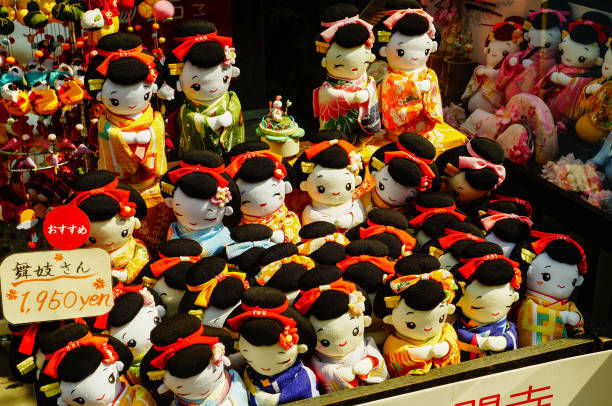The Art of Kokeshi Dolls: A Timeless Tradition of Japanese Craftsmanship
- torinaga11
- Feb 7
- 4 min read

Discover the art of Kokeshi dolls, a timeless tradition of Japanese craftsmanship. Learn about their history, types, and cultural significance, and find out how to start your own collection.
Kokeshi dolls, with their simple yet elegant designs, are one of Japan’s most iconic traditional crafts. These handcrafted wooden dolls, originating from the Tōhoku region, have captivated collectors and art enthusiasts worldwide. In this blog post, we’ll explore the history, craftsmanship, and cultural significance of Kokeshi dolls. Whether you’re a collector, a lover of Japanese culture, or simply curious about these charming figurines, this guide will provide a deep dive into the art of Kokeshi dolls. Optimized with SEO-friendly keywords like "Kokeshi dolls," "Japanese wooden dolls," "traditional Japanese crafts," and more, this post is designed to rank high on Google and attract readers searching for information about this timeless art form.
What Are Kokeshi Dolls?
Kokeshi dolls are traditional Japanese wooden figurines characterized by their cylindrical bodies and round heads. They are typically hand-painted with floral or geometric patterns and lack arms or legs. These dolls are not just decorative items—they are a symbol of Japanese craftsmanship and cultural heritage.
Key Features of Kokeshi Dolls:
Materials: Made from wood, often cherry or Mizuki (dogwood).
Design: Simple, minimalist shapes with intricate hand-painted patterns.
Origins: Created in the hot spring regions of Tōhoku, northern Japan.
Purpose: Originally crafted as souvenirs for hot spring visitors, they are now cherished as collectibles and cultural artifacts.

The History of Kokeshi Dolls
The origins of Kokeshi dolls date back to the early 19th century during the Edo period. They were first created by woodworkers in the Tōhoku region, known for its hot springs and skilled artisans.
Historical Significance:
Hot Spring Souvenirs: Kokeshi dolls were initially sold as souvenirs to visitors of the region’s hot springs.
Folk Art: Over time, they evolved into a form of folk art, reflecting the culture and traditions of the Tōhoku region.
Symbol of Resilience: After World War II, Kokeshi dolls became a symbol of hope and resilience, as artisans revived the craft to support their communities.
Today, Kokeshi dolls are celebrated as a quintessential part of Japanese culture and are often associated with themes of simplicity, beauty, and tradition.
Types of Kokeshi Dolls
Kokeshi dolls can be categorized into two main types: Traditional Kokeshi and Creative Kokeshi.
1. Traditional Kokeshi (Dento Kokeshi)
Traditional Kokeshi dolls adhere to strict design principles passed down through generations. They are produced in specific regions of Tōhoku, each with its own unique style.
Popular Styles of Traditional Kokeshi:
Tsuchiyu Kokeshi: Known for their bold, colorful patterns.
Naruko Kokeshi: Features a squeaking head, created by a special joint.
Yajirō Kokeshi: Characterized by a slender body and delicate painting.
Zao Kokeshi: Recognizable by their wide, round heads and simple designs.
2. Creative Kokeshi (Shingata Kokeshi)
Creative Kokeshi dolls break away from traditional designs, allowing artisans to express their individuality. These dolls often feature modern patterns, vibrant colors, and unique shapes.
Why Creative Kokeshi Are Popular:
Artistic Freedom: Artists can experiment with new styles and techniques.
Appeal to Collectors: Their uniqueness makes them highly sought after.
Modern Aesthetic: They blend traditional craftsmanship with contemporary art.

The Craftsmanship Behind Kokeshi Dolls
Creating a Kokeshi doll is a meticulous process that requires skill, patience, and a deep understanding of the craft. Here’s how they are made:
Step-by-Step Process:
1. Wood Selection: Artisans choose high-quality wood, often cherry or Mizuki, known for its durability and fine grain.
2. Carving: The wood is carefully carved into the doll’s cylindrical body and round head using lathes and hand tools.
3. Sanding: The surface is smoothed to create a flawless finish.
4. Painting: Intricate patterns are hand-painted using natural dyes and brushes. Traditional designs often include chrysanthemums, cherry blossoms, or geometric motifs.
5. Finishing Touches: The doll is coated with wax or lacquer to protect the paint and enhance its shine.
Why Kokeshi Craftsmanship is Special:
Handmade: Each doll is unique, reflecting the artisan’s skill and creativity.
Sustainable: Made from natural materials, Kokeshi dolls are eco-friendly.
Cultural Heritage: The techniques have been passed down for generations, preserving a vital part of Japanese culture.
The Cultural Significance of Kokeshi Dolls
Kokeshi dolls are more than just decorative items—they hold deep cultural and symbolic meaning in Japan.
Symbolism of Kokeshi Dolls:
Simplicity and Elegance: Their minimalist design reflects the Japanese aesthetic of *wabi-sabi* (finding beauty in simplicity).
Good Luck Charms: Kokeshi dolls are often given as gifts to bring good fortune and happiness.
Connection to Nature: Made from wood and painted with natural dyes, they symbolize harmony with nature.
Modern-Day Significance:
Collectibles: Kokeshi dolls are highly prized by collectors worldwide.
Cultural Ambassadors: They represent Japanese craftsmanship and culture on the global stage.
Tourist Souvenirs: Visitors to Japan often purchase Kokeshi dolls as mementos of their trip.

How to Start Collecting Kokeshi Dolls
Interested in starting your own Kokeshi doll collection? Here’s how to get started:
1. Learn the Basics: Familiarize yourself with the different types and styles of Kokeshi dolls.
2. Visit Japan: Travel to the Tōhoku region to purchase authentic dolls directly from artisans.
3. Shop Online: Many reputable sellers offer Kokeshi dolls through online marketplaces.
4. Attend Craft Fairs: Look for Japanese cultural events or craft fairs where Kokeshi dolls are sold.
5. Care for Your Collection: Keep your dolls away from direct sunlight and humidity to preserve their beauty.
The Future of Kokeshi Dolls
While Kokeshi dolls are rooted in tradition, they continue to evolve with the times. Here are some trends shaping their future:
Modern Designs: Creative Kokeshi dolls are gaining popularity among younger generations.
Global Appeal: Kokeshi dolls are becoming a symbol of Japanese culture worldwide.
Sustainability: Artisans are increasingly using eco-friendly materials and techniques.

The Enduring Charm of Kokeshi Dolls
Kokeshi dolls are a testament to the beauty of Japanese craftsmanship and tradition. From their humble beginnings as hot spring souvenirs to their status as cherished collectibles, these wooden figurines have captured the hearts of people around the world. Whether you’re drawn to their simplicity, their cultural significance, or their artistic beauty, Kokeshi dolls offer something for everyone.
So, why not start your own Kokeshi collection or learn more about this fascinating art form? The world of Kokeshi dolls is waiting to be explored!
#KokeshiDolls #JapaneseCraftsmanship #TraditionalJapaneseArt #HandmadeDolls #JapaneseWoodenDolls #KokeshiArt #TōhokuCrafts #FolkArt #KokeshiCollectors #CulturalHeritage #JapaneseAesthetic #WabiSabi #CreativeKokeshi #DentoKokeshi #KokeshiHistory #KokeshiCulture #KokeshiDesign #JapaneseTradition #KokeshiCollecting #ArtisanCraftsmanship


Comments